CHAPTER SIX
OTHER KINDS OF TRACES
When Halloran and Danny have their private conversation in the hotel kitchen, we are given the following explanation of what their shared psychic power is, “Well, you see Doc, when something happens it can leave a trace of itself behind. Say like if someone burns toast. Well, maybe things that happen leave other kinds of traces behind. Not things that anyone can notice, but things that people who shine can see. Sometimes they see things that haven’t happened yet. Sometimes they see things that happened a long time ago.”
This simple description applies not just to Danny’s experience, but also to the actual film structure. Repeatedly throughout The Shining, Kubrick bombards us with visual, auditory and conceptual hints of what is about to happen next. It’s a common psychological device in film, sometimes referred to as foreshadowing, and has been used by suspense masters like Hitchcock. In The Shining however, the use of foreshadowing fits in as a narrative device. It makes the audience share Danny's psychic traumas of the hotel.
- During the conversation with Halloran Danny asks “Mr Halloran, are you scared of this place?”, and immediately we cut to our first wide shot of their conversation, which shows a set of knives in the background pointing directly at Danny’s head – a hint of the murderous danger that awaits the family.
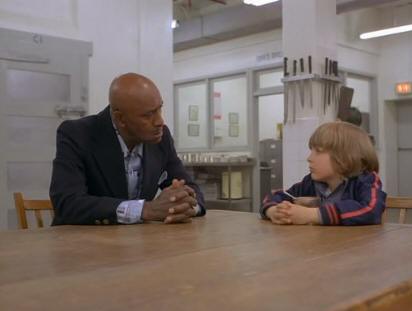
- Jack's knowledge of a former caretaker murdering his family is also foreknowledge for the audience of the films coming events.
- Aside from the obvious on-screen flashes of the twin ghost girls prior to Danny seeing their dead bodies, we are subliminally hinted of their presence several times when the Torrance’s are being shown around the hotel. At least three times we see women in pairs carrying luggage about. Two of these pairs are heard wishing goodbye to Mr Ullman. The most prominent link between these women and the twin girls is that the pair we see outside Jack’s apartment are seen with a portion of hallway in the background that features the same blue and white flowered wallpaper that we see when the twins’ dead bodies are revealed. This wallpaper appears at no other point in the film.
 
- In the first tricycle scene the red floors of the hallway may be a subliminal foresight of the river of blood, which Wendy sees in the films climax. The red painted hall that she walks down just prior to seeing the river of blood is also a subliminal to this effect.
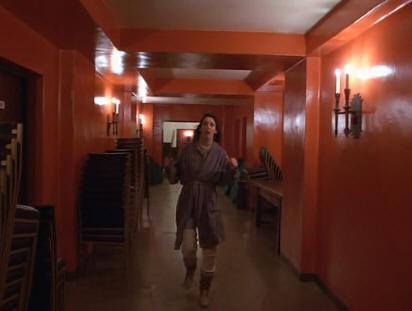
- Danny being chased playfully by his mother into the hotel maze anticipates him being chased by his kill-crazy father. Her teasing dialogue also mimics the close proximity with which the camera chases Danny, “I’m gonna getcha. You better run fast. Look out. I’m coming in close.” She even reaches out with her arms as if about to strangle him like the woman in room 237.
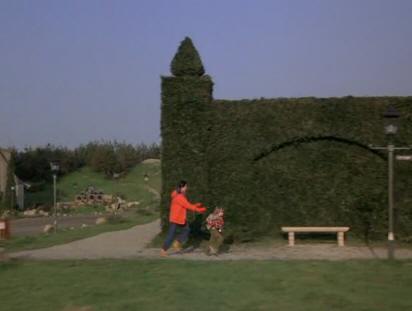
- The sound of the tricycle wheels alternating between the carpet and floorboards sound uncannily like the music when Danny is chased through the freezing maze by his father.
- When Jack is chopping his way through the bathroom door we see a shot in which Wendy is crying and screaming in the background on the right portion of the screen. On the left of the screen we see the tip of the axe repeatedly smashing through the wood of the door. This visual arrangement almost looks like Wendy is actually being killed with the axe. All we're missing is the blood.

- In Danny’s vision of the murdered twins, Kubrick very subtly uses this device again. We begin with a shot of Danny riding off into the distance in a green hallway and taking a right turn. The accompaniment of dramatic music let’s us know we’re about to see something scary. As Danny then turns a left corner the musical drum of surprise kicks in a second before the ghost girls have appeared on screen. It’s as if the music was anticipating what was around the corner.
- The scene of the dead girls may also be foreshadowing Wendy’s discovery of Halloran’s body. She takes a right turn then a left before seeing his blood soaked corpse. In both scenes the camera takes us in for a close up. One with a series of visual cuts and one with a fast zoom.
- The overwhelming red and white decor of the Goldroom lavatory may be a subliminal representation of the historic bloodbath that has been and is yet to come again.

- The lavatory scene in which Danny has his first Shining episode features a shower curtain draped over a bath tub with Danny looking into a mirror on the right wall. This composition matches that of Jack's encounter with a naked woman later in the story and both scenes feature variations on the same piece of music.
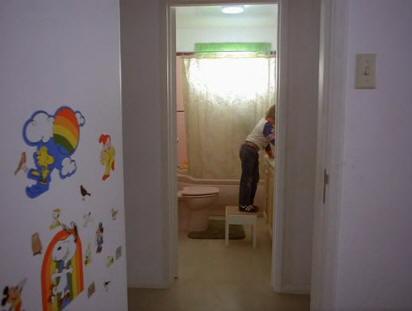 
- As Wendy wheels a tray with Jack’s breakfast through the lobby, she walks the exact same path that Halloran does in his death scene. As Wendy is about to reach the pillar that Jack hides behind the scene ends and we cut to a different part of the hotel.
 
- Jack's repeated throwing of a tennis ball at the wall above the fireplace is our foresight that he will later be chopping through doors with an axe in pursuit of his family. Note the loud echoing bang of the ball and compare it with the slamming thud as Jack chops through doors.
 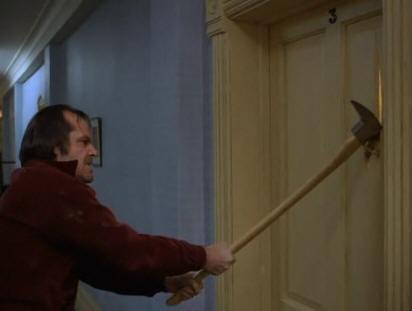
- An additional reinforcement of tennis ball throwing as a metaphor for axe swinging is that Jack slams the ball against the floor just a few metres away from where he later kills Halloran. He then throws the ball toward the position where Wendy stands when she sees Hallorans body. Notice also that there are toys scattered about the floor including, to Jack's left, a small black teddy bear with its torso clothed in red - a foresight of Halloran's death. This all links up with Jack's comment that “all work and no play makes Jack a dull boy”, which translates as “all work and no murder ...”.
 
- The above scene is also a subliminal link to the deaths of the twin girls. They ask Danny to come and play with them and Jack slams the ball to the floor where Danny has been playing. This is a good example of Kubrick weaving multiple metaphors into a single shot.
- Another example of playful ball throwing as a foreshadow of axe swinging is that Danny and Wendy are shown throwing snowball’s at each other outside. This happens as Jack stands staring with madness out of the Colorado Lounge windows.
Some other interesting, but slightly less conclusive examples are:
- The psychiatrist telling Wendy that “kids can scare you to death” which anticipates the vision of the dead twins – often cited as the film’s scariest moment.
- The word “Stovington” on Jack’s t-shirt (when he’s eating breakfast) viewed backwards through the very same mirror that Wendy sees Danny’s REDRUM graffiti.
- And a man dressed almost completely in white who stands staring over the table top maze in the same stance that Jack does (he can be seen in the far background as Jack tells his wife he’s got the job). This position of this ghost-like man in white is on the opposite side of the table to where Jack stands, and so may be conceptually tied in to the mirror image maze that Jack sees in the tabletop model.
 
There are many examples of the film using subliminal association to force us into experiencing little Danny's terrible “shining” visions. Perhaps this simulated psychic vision is another root of the film's sense of unseen menace. What could be more frightening than being a solitary child ... with psychic foresight and an over-active imagination ... running away from a murderous adult ... in an endless maze that plays spatial tricks on the mind?
PREVIOUS CHAPTER
NEXT CHAPTER
CHAPTER LIST
MAIN SITE PAGE
|
















